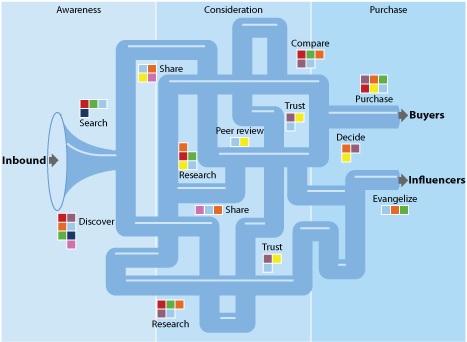Understanding the B2B buying process is an essential part of creating effective sales and marketing strategies. To help you identify, engage, and nurture potential customers in an increasingly competitive space, I’m taking a look at the four crucial ways the B2B buying process is changing.
1. THE BUYING PROCESS IS GROWING MORE COMPLEX
Technology is developing at a rapid pace, especially within the B2B sector. Decision makers are faced with increasingly complex problems, and they often need to decide between growing numbers of potential vendors to solve them. B2B buyers engage with these vendors through an average of six distinct channels, and find their buying decisions influenced by information from hundreds of different sources.
As a result, the modern B2B buying process looks less like a linear path from first contact through to sale—it’s more like a spiderweb of social influence and research channels.
Reaching these buyers at all stages of their journey—and engaging them the right way—requires a diverse stable of content.
Businesses need to make use of owned content (blog posts, whitepapers, and guides), earned content (guest posting, customer testimonials, and product reviews), and paid content (content advertising and promotion, magazine articles and syndication) in order to create the right assets for helping potential customers through a complicated and confusing buying journey.
2. THE BUYING PROCESS IS MORE COMPETITIVE
There was a time when big businesses dominated the buying journey, using their monopoly on information to drive visitors toward a handful of vendors. Now, B2B buyers have access to a staggering wealth of information and resources, making it easier than ever for buyers to assess and evaluate competing products and services.
Self-conducted research: Thanks to a growing abundance of educational content resources, the average B2B buyer has completed between 50 and 90% of the buying journey by the time they make first contact with your business
Increased competition: An increasing trend toward self-conducted research means that your content is battling for visibility and engagement, with visitors consuming ten pieces of third-party content for every one piece created by your business
Earned content: During the buying process, the average buyer engages with three pieces of content about your business for every piece of content written by your business. Owned content alone isn’t always enough to engage buyers, and B2B businesses will benefit from a defined earned media strategy
3. THE BUYING PROCESS IS MORE SOCIAL
Social media has held sway over the B2C buying process for years. Increasingly, we’re seeing the same changes occur in the B2B sector.
Growing numbers of businesses are leveraging social media as a channel for engaging potential customers. In doing so, decision makers are often turning to peer networks like LinkedIn to inform their sales decisions.
Brand research: Over 70% of B2B buyers use social media as a research tool. This typically means following potential suppliers, engaging with their content and advice, and analyzing the feedback of their social networks
Peer discussions: More than half of B2B customers use social media networks to engage their peers in conversation. Industry-specific groups and forums make it easier than ever to connect to people from the same sector, and discuss product recommendations and customer experiences
Social proof: Roughly 22% of all B2B buyers explicitly use the recommendations of their social media networks to inform their purchasing decisions. A glowing social media recommendation from a past customer or industry figurehead can do more than boost your brand image—it can actively increase your sales
4. CONTENT CAN INFLUENCE THE BUYING PROCESS
All of these statistics speak to one fundamental takeaway in today’s B2B buying process: content matters.
Over two-thirds of the entire B2B buying process now takes place online. More than half of decision makers start this buying journey with informal research, using search engines and business blogs to research products, problems, and solutions. It’s this stage of research where your content can have a real impact on sales.
Most Influential Research Channels
- Search engines
- Vendor blogs
- B2B verticals
- Industry e-zines
- What about LinkedIn (editor add)
By having a defined content-driven marketing strategy, your business has a way to engage buyers through each of these channels. It becomes possible to interact with decision makers throughout the sales process, using educational resources, peer recommendations, and decision-making advice to make sense of a confusing buying journey. It allows you to position your business as a valuable ally and, in the process, create loyal lifetime customers.
Source @kapost
http://marketeer.kapost.com/b2b-buying-process/#axzz3YRqsCAZr




